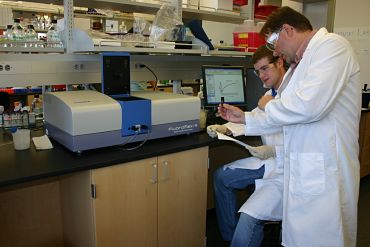
For Immediate Release
Thursday, September 20, 2012
For more information:
Contact Kari Bonaro
kbonaro@bnmc-old.local, 716-218-7157
Buffalo Niagara Medical Campus Receives Three Honors in One Day by Different International & State-Wide Organizations
Received Outstanding Research/Science Park, Planning Excellence, and Innovative Workspace Awards
(BUFFALO, NY) – The Buffalo Niagara Medical Campus received three honors on the same day this week: the BNMC was named 2012 Outstanding Research/Science Park by the Association of University Research Parks; its Four Neighborhoods, One Community: Buffalo Niagara Medical Campus Master Plan Update has been awarded the 2012 Planning Excellence Award for Comprehensive Planning by the New York Upstate Chapter of the American Planning Association (NYUAPA); and the Thomas R. Beecher Innovation Center, owned & operated by the BNMC, Inc., received the Innovative Design Award by international trade organization Global Workspace Association.
2012 Outstanding Research/ Science Park Award by Association of University Research Parks (AURP)
Patrick J. Whalen, Chief Operating Officer of the Buffalo Niagara Medical Campus, Inc., was on hand to accept the award at AURP’s annual conference in Madison, WI. The BNMC has submitted a proposal to host the group’s 2014 meeting here in Buffalo.
The Association of University Research Parks is a professional association of university related research and science parks. AURP’s mission is to foster innovation, commercialization and economic growth through university, industry and government partnerships. More online at www.aurp.net.
Previous parks honored as Outstanding Research/Science Park of the Year include the Research Park at the University of Illinois at Urbana-Champaign; Virginia Tech Corporate Research Center; Innovation Place (Saskatoon, Saskatchewan, Canada); Sandia Science & Technology Park (Albuquerque, NM); and Centennial Campus at North Carolina State University.
2012 Planning Excellence Award for Comprehensive Planning from the New York Upstate Chapter of the American Planning Association
In addition, the New York Upstate Chapter of the American Planning Association (NYUAPA) announced that the Four Neighborhoods, One Community: Buffalo Niagara Medical Campus Master Plan Update has been awarded the 2012 Planning Excellence Award for Comprehensive Planning. The 2012 NYUAPA Awards recognize outstanding work that is being done by planners and planning firms in Upstate New York. Planning Excellence Award for Comprehensive Planning recognizes plans that advance the science and art of planning.
“The Four Neighborhoods, One Community plan used a visionary wp-contentroach that engaged stakeholder groups in a significant way and leveraged their collective knowledge to shape the final product,” said NYUAPA Awards Committee Chairman Mark Castiglione, AICP. “What’s more, not only does the plan include excellent analysis, writing, and graphics, but it builds on and seeks to implement existing community and neighborhood plans. In doing so, the NYUAPA feel this plan is a model for others to emulate and is well deserving of this prestigious award.”
2012 Innovative Design Award by the Global Workspace Association
This new, annual award was given out at GWA’s annual convention today in Baltimore, MD. The award is given to a member with a center who developed an innovative or unique design that positively affected client retention or center ‘sale-ability’ by addressing a particular challenge presented by the building or the environment. The Innovation Center was honored for tenant amenities such as exercise balls, Xbox Kinect, pool table, electric car chargers, and more.
About the BNMC
The Buffalo Niagara Medical Campus (BNMC) is dedicated to the cultivation of a world-class medical campus for clinical care, research, education, and entrepreneurship on 120 acres in downtown Buffalo. It is home to the region’s top clinical, research, and medical education institutions, including: the University at Buffalo, Roswell Park Cancer Institute, Olmsted Center for Sight, Kaleida Health, Hauptman-Woodward Medical Research Institute, Buffalo Medical Group, Buffalo Hearing & Speech Center, Unyts, and the Center for Hospice and Palliative Care. There are over 40 public and private companies on the BNMC. More than 12,000 people come to work at the Medical Campus every day, and BNMC institutions see over one million patients and visitors annually. The Campus has an annual economic impact of $1.5 billion on the region. The Medical Campus consists of more than 6 million square feet of research, clinical, and support space. bnmc-old.local
About the BNMC, Inc.
The BNMC, Inc. is the umbrella organization created in 2001 by the institutions located within the Medical Campus. Our not-for-profit organization fosters conversation and collaboration among our member institutions, their 12,000 employees, and the community; coordinates activities related to sustainable planning, development and enhancement of our 120-acre space; and works to create a distinct, innovative environment that provides opportunities for entrepreneurship and active and healthy living. Learn more at bnmc-old.local.
###







![[ photograph ]](http://www.buffalo.edu/news/thumbnails/J-Craig-Venter-UB.jpg)















![[ photograph ]](http://www.buffalo.edu/news/thumbnails/WhiteCoatCeremony.jpg)


![[ photograph ]](http://www.buffalo.edu/news/thumbnails/Anne-Curtis-11.jpg)



![[ photograph ]](http://www.buffalo.edu/news/thumbnails/talal_andrew.jpg)
![[ photograph ]](http://www.buffalo.edu/news/thumbnails/dubocovich.jpg)